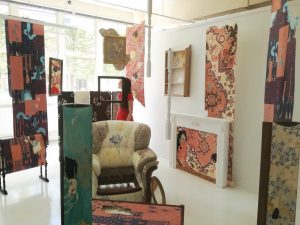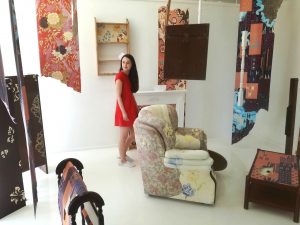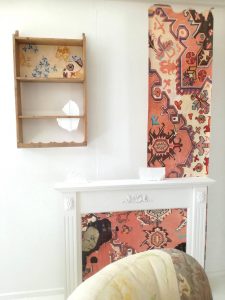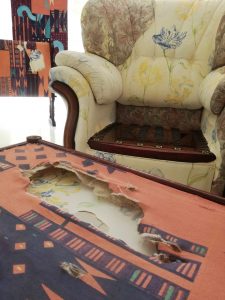Poetics of Space (2014)
We comfort ourselves by reliving memories of protection. Something closed must retain our memories, while leaving them their original value as images.’ – Gaston Bachelard (1958)
Through a notion of expanded painting, my work translates our relationship to the everyday domestic environment. This takes its stance in the idea that viewers are able to feel ‘at home’ within a painting. My practice substitutes the traditional canvas frame with domestic surroundings, making a contemporary stance on painting, and art within the home.
Where the domestic is designed to provide shelter, it also bears witness to the effects of time. Thus, my painting conceives a space that combines dwelling, nostalgia and decay. This recalls childhood belonging, a connection with the domestic that we attempt to recreate in new spaces throughout life. Viewers are asked to question whether the shelter of the childhood home truly exists, or if it simply lies in their nostalgic sentimentality.
Fireplace development
Similarly to the armchair, my transformation of the fireplace followed my technique of using furniture to replace the traditional canvas frame. Again, this translated pattern from my own childhood home, in this case a carpet, which became the influence for the painting.
However, this pattern was photoshopped to experiment with rips, spray painting and simplification of pattern, to suggest new painterly possibilities. The video above shows how this painting developed.
The final intervention of rips into the canvas followed my previous transformation of piano lid canvases. This technique brings a sense of decay and disintegration, which are crucial components to my practice, suggesting gradual loss of memory and connection to the childhood home. By increasing the depth and number of these layers, we are given a sense of pattern revealing stories of the past. After experimenting with different layers and authenticity of the rip, the final result aimed to resonate pattern of the surrounding space, which will become a spatial conversation of disintegrating painted histories
Installation decisions
Whilst photoshop allows initial designs, many decisions had to be made during installation.
The use of plaster fragments became a consideration. Despite initially planning on hanging these throughout the space, the white fragments appeared to possess meaning in their leaning against domestic objects as if abandoned, thus generating a sense of passed time. Using the shelves and fireplace as a place for usually displaying domestic ornaments, these fragments are given a sense of value in their placement, hinting at the significance of histories gone before. I also experimented with fragmented frames to echo the gold frames suspended throughout the space, to become part of the conversation occurring within the installation. However, I felt the minimalist installation of three fragments created meaningful negative shapes within the painted space, resonating the banisters hung in front of them. Viewers are given a sense of disintegration, not only in the painted canvases of surrounding objects, but also in the remnants of surrounding walls.
Mirror orientation was also an important factor in installation. These were experimented to find the most successful point of reflection, that confused reflected pattern with actual painting.



